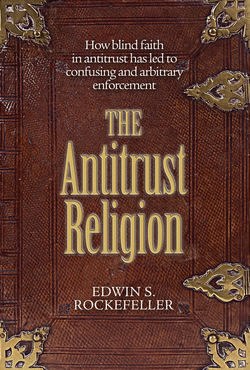The Antitrust Religion

Реклама. ООО «ЛитРес», ИНН: 7719571260.
Оглавление
Edwin S. Rockefeller. The Antitrust Religion
Acknowledgment
Introduction
1. What Is “Antitrust”? Quasi-religious Faith Distinct from the Antitrust Statutes
Vague Statutes—Unaccountable Discretion
No Clear Rules—Arbitrary Decisions
Futility of Reform
Change through Rejection of the Faith
2. The Antitrust Community
Development of the Antitrust Community
Law School Indoctrination in Elements of Antitrust
Sinister-Sounding Terms—Self-righteous Feelings
3. From “Trust-Busting” to the Present
Pre-1980 Enforcement—Mutually Exclusive Goals
Attempt at a Rational Basis in Economic Theory
Consumer Welfare Economics Takes Over as Rhetoric— Protectionist or Fairness Strain Lives On
4. The Magic of “Market Power”
“Market” Is Metaphor; It Can Only Be Assumed and Cannot Be Proven
Market Power—Imagined and Unverifiable
“Market Power” Label—A Disguise for Subjective Decisions
5. Monopolization
Unsuccessful Attempts to Give Meaning to the Statutory Prohibition of Monopolization
From Standard Oil to IBM to Microsoft—the Successful Competitor Turned upon When He Wins
6. Mergers
All Mergers Are Illegal—Some May Be Allowed
Guidelines That Do Not Guide
Examples of Unpredictability
No Rule of Law as to Corporate Mergers
7. “Tying” and “Exclusive” Dealing
Does Prohibition of Tying Make All Sales on Credit Illegal?
Unsuccessful Government Effort to Break Up Microsoft— Further Obfuscation of Tying Law
8. Price Fixing
Some Agreements as to Price May Produce Efficiencies—Some May Not
Treble Damage Actions—No Obvious Benefit to the Public
9. In Conclusion
Reformers
Antitrust Belief Embedded in American Psyche—Repeal of Antitrust Statutes Politically Impossible
Notes
About the Author
Cato Institute
Отрывок из книги
Robert A. Levy, Senior Fellow of the Cato Institute, provided substantial editorial assistance. His help is gratefully acknowledged.
Thurman Arnold, assistant attorney general for antitrust in the New Deal, described the origin of and need for the religion of antitrust in the following manner:
.....
Most government activity under the antitrust statutes finds its support in section 7 of the Clayton Act, which prohibits corporate acquisitions “where … the effect of such acquisition may be substantially to lessen competition, or to tend to create a monopoly.” Yet we have no workable definition of what constitutes “competition” and no way to measure it. Applying section 7, the Supreme Court under Chief Justice Earl Warren essentially declared all corporate mergers unlawful. Expressing concern with industrial “concentration” and desiring to protect “small business” from more efficient competitors, the Court during the 1960s decided every case in the government’s favor. First came the Brown Shoe case,8 which involved the acquisition by Brown (primarily a shoe manufacturer) of Kinney (primarily a shoe retailer). The Court held the merger illegal under section 7 in two ways: first, as a horizontal merger and, second, as a vertical merger. Both companies made shoes. Brown made roughly 4.0 percent and Kinney made roughly 0.5 percent of the nation’s shoes. Merger of the two manufacturers, said to be “horizontal” because it involved two companies directly competing with each other, was found illegal. The Court also held the merger of Brown and Kinney illegal as a “vertical” merger—i.e., one involving two companies that had a supplier-customer relationship—because Brown, selling 4.0 percent of the nation’s shoes, merged with Kinney, a retailer that accounted for 1.2 percent of U.S. retail shoe sales. The vertical merger of the supplier Brown with its customer Kinney was said to “foreclose” a share of the retail market otherwise open to manufacturer-competitors of Brown.
Four years later, in the Von’s Grocery case,9 the Court concluded that section 7 prohibited the merger of two grocery chains because the merger would result in ownership by a single firm of 1.4 percent of the grocery stores in the Los Angeles metropolitan area, accounting for 7.5 percent of the area’s grocery sales.
.....